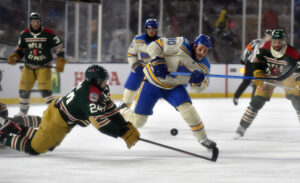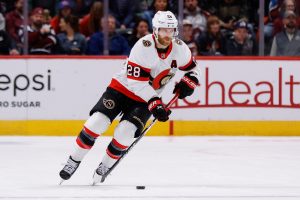In early July of 2022, the St. Louis Blues traded goaltender Ville Husso to the Detroit Red Wings. In the two years since the trade, it was unclear who was the winner of the trade, if either team. However, the news of Husso being placed on waivers and sent down the minor leagues clinches a victory for the Blues. Furthermore, the trade has been a win in other ways for the Blues Note.
Why the Trade Happened?
At the time of the trade, Husso was coming off a breakout season with the Blues. He had a 25-7-6 record, a .919 save percentage and a 2.56 goals-against average. In addition, Husso took over as starter from a struggling Jordan Binnington. Husso started the Stanley Cup Playoffs as the starter, but lost it to Binnington. However, an injury to Binnington in the second round forced Husso back in goal, where he struggled as the Blues were eliminated.
Despite the struggles in the playoffs, Husso had emerged as a starter in the NHL. As an unrestricted free agent, Husso was due to get paid as a starter. With the Blues already committed to Binnington, and the Red Wings seeking a starter, the trade was made.
After acquiring their new starter, the Red Wings stated their commitment to Husso by signing him to a contract worth $4.75 million a season.
How Have the Blues Won the Trade?
Binnington vs. Husso
The Blues essentially had to choose between Husso and Binnington. The Blue Note had at least moderate interest in re-signing Husso before deciding to part ways. However, the Blues maintained their commitment to Binnington.
In the two years since the trade, Husso has posted a .894 save percentage alongside a .325 goals against average. Conversely, Binnington has posted a .903 save percentage alongside a 3.07 goals against average. While those are not eye-popping numbers on paper, Binnington has played exceedingly well despite not always having the best team in front of him.
In short, Binnington has continued to play like a number one goalie, while Husso has struggled. The Blues made the right decision in maintaining their commitment to Binnington.
Joel Hofer
If the Blues had re-signed Husso, Joel Hofer would not have gotten the opportunity at the NHL level, at least not with the Blues. In his first-full season last year as the Blues backup goalie, Hofer posted a .913 save percentage alongside a 2.65 goals against average. Furthermore, Hofer even earned starts late in the season while the Blues were battling for a playoff spot.
Binnington and Hofer have formed one of the best goaltender tandems in the NHL. The departure of Husso created the opportunity for this to happen. Hofer has impressed to the point that the Blues should consider offering him an extension in order to guarantee the tandem stays together for multiple seasons.
Cap Space
Ah, yes. Cap space. The inclusion of cap space in an analysis of the Blues has been common the last few seasons. However, its placement in this analysis is as appropriate as it has been in others.
By not re-signing Husso, the Blues saved in the ballpark of $4.75 million in cap space. This is money the Blues have been able to allocate into different parts of their roster. Newcomers Dylan Holloway and Alexandre Texier, for example, have a combined salary of roughly $3.4 million. Another newcomer, defenceman Ryan Suter, is making $775,000. Furthermore, Joel Hofer is making $775,000.
For around the cost the Red Wings are paying Hofer to play in the minor leagues, the Blues have signed two forwards, one defeneman, and their backup goalie. All four have a part to play in the Blues retool.
Do Not Forget the Draft Pick
In the trade, the Blues acquired the 73rd overall pick in the 2022 NHL Entry Draft. With the pick, the Blues selected Aleksanteri Kaskimaki. A left-handed centre, Kaskimaki is a fast skater who can get down the ice quickly. Furthermore, Kaskimaki has a quick shot, which resulted in 48 points in 18 games in the 2019-20 Finland U-16 league.
Kaskimaki has only played in a few American Hockey League games, so his NHL debut is still a bit away. However, he is someone to keep an eye on as he continues to develop. When you think of quick left-handed shots in Blues history, Vladimir Tarasenko comes to mind right away. Does this mean Kaskimaki is the next Tarasenko? No. However, it means he is someone to watch.
The Blues have already benefited in many ways from the Husso trade. To think that Kaskimaki could be coming to the NHL in a few seasons could be icing on the cake for the Blues.
Is This the Final Verdict?
The Red Wings have said they have not given up on Husso. It appears that there is still an opportunity for Husso to return to the NHL with the Red Wings and help them win. If Husso helps them win a Stanley Cup, then the front office will be celebrated just as the Blues front office was for making the famous trade for Ryan O’Reilly.
However, the Blues have already won their side of the trade. Whether it be cap space, Joel Hofer, or the promise of a young draft pick, the Blues have benefited from trading away Husso. This is another trade in the win column for Blues general manager Doug Armstrong.
Well done, Army. Well done.
Main Photo: Jeff Curry-Imagn Images






